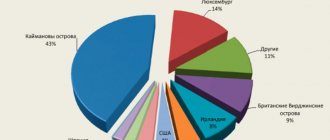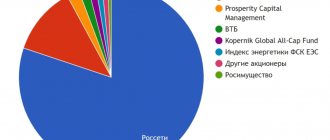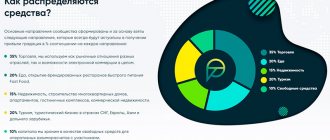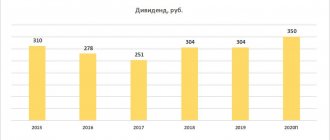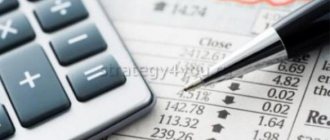If you know the difference between simple and compound interest, then you understand that reinvesting over the long term greatly increases the profitability of your investment. There are legends about forgotten bank accounts and crypto-wallets in which millions have accumulated... However, the other side of the coin should not be underestimated either - reinvestments are easy to lose along with the initial deposit, and this is doubly offensive.
From this article you will learn:
- What is reinvestment in simple words
- Reinvestment using real examples
- Reinvesting profits - pros and cons
- Where should you reinvest profits and where not?
Before we move on, a little blurb:
I would like to recommend you the investment accounting service from the partner of the Webinvestor Blog - the company Intelinvest . On it you can monitor your portfolio through the website or mobile application, and you do not need to provide passwords to import transactions. You can keep track of any assets: stocks, bonds, cryptocurrencies, precious metals, forex investments, etc. There is a functional free version for testing. If you would like to make a full subscription, use promo code 1VYV9CMSTD to get 20% off your first payment.
Thank you for your attention, let's continue!
Reinvestment rate
The reinvestment ratio is a measure of profitability expressed as a percentage. It shows the level of reinvestment of capital in investment activities, and the higher its value, the higher the profit for subsequent investment.
Reinvestment can be of two types:
- complete, in which all profits received are directed to investment activities
- partial, in which not all the profit received is reinvested, but part of it
Depending on the type, the reinvestment ratio can be equal to 100% (with the first option) or 0-99% (with the second option). In some cases, the investor can independently decide what type of reinvestment to use, for example, invest 50% of the received dividends, and use the second 50% for their own purposes. However, in some situations, the user of financial instruments can only choose how to use the profits received - to reinvest or not. For example, when opening a bank deposit, the client is asked to either add all accrued interest to the principal amount (reinvestment or capitalization) or store it in another account.
Adviсe
To successfully reinvest, listen to the recommendations:
- Stick to the principle of diversity, this will protect you from market changes and reduce risks. Use a variety of investment tools, don't get stuck on one. So, if you fail in one, other sources of income will remain.
- Be rational, calculating, give yourself time to think before making serious decisions. There should be no emotions or rash actions in reinvesting.
- Developing a financial strategy and sticking to it is an effective way to achieve success.
Reinvestment of interest
Reinvestment of interest on bank deposits is called capitalization, in which accrued profit in the form of interest is added to the principal amount. This allows you to increase your income, since interest will be charged again, since the principal amount of the deposit will be increased by this amount.
Capitalization or reinvestment in this case is called compound interest, when interest under the contract is calculated on accrued interest. Its calculation is based on a special formula, and for the convenience of clients, on each official website of a credit institution there is a calculator for quickly calculating the profit possible to receive.
The amount received when reinvesting interest depends on several factors, namely:
- interest rate under a bank deposit agreement
- interest accrual period (monthly, quarterly, at the end of the term)
- the period for which the bank deposit agreement is concluded
Naturally, the higher the interest rate and the term of the contract, the higher the profit the investor can receive. The amount of profit on reinvestment may also be higher if interest is capitalized with high frequency, since the mechanism will begin to work at an earlier date. However, this point is also taken into account by credit institutions, and therefore for deposits with monthly capitalization the interest rate may be slightly lower than in the absence of the possibility of capitalization or reinvestment.
Note that an investor can sometimes independently choose the option of whether to reinvest the interest or not, and in order to obtain higher profits, it is necessary to pay attention to this point when concluding an agreement.
Usage
Currently, the reinvestment process is actively used all over the world. Its use contributes to a significant increase in the profitability of the initial investment and does not depend on the starting size. Each time you replenish your deposit, you should remember that funds are added to the initial investment, and interest is calculated on the amount that was formed after replenishing the account.
Many banks offer exclusive conditions for depositors, involving reinvestment of profits, thereby creating mutually beneficial cooperation between the investor and the bank. For any investor, the possibility of reinvesting interest is a real chance to increase the amount of initial capital in a short period of time, receiving funds that provide passive income.
Reinvesting is considered a simple and effective way to increase capital, which is used by most successful investors who understand that the more money they invest, the more profit they will receive. The essence of reinvesting profits is to reinvest them in the same assets where the initial investments were made or in some other financial instruments.
If we consider the first case, here the interest is calculated on the new, replenished amount; in the second case, the investor is given the opportunity to choose riskier and more profitable investments. There is also a mixed option, which involves reinvesting one share of profits in the initial investment, and the other share in new investment products. In addition, reinvestments can be focused both on a long period of time and on the use of short-term speculative tactics.
Reinvestment formula
The simplest form of interest reinvestment can be represented as follows:
Deposit amount = principal amount + (principal amount * interest)N
where the principal amount is the funds contributed by the investor or received as a result of previous capitalization;
interest - interest rate under the deposit agreement;
N is the number of periods for placing funds.
This formula is convenient to use if capitalization is carried out annually, since the interest rate on the deposit is indicated as annual interest. If capitalization is carried out more often, then changes must be made to the formula:
Deposit amount = principal amount + (principal amount * )N
where the capitalization period is 2 (six months), 4 (quarterly), 12 (monthly).
An example of calculating interest reinvestment (the interest rate is the same and equal to 6%):
| Capitalization period | Initial amount | Calculation of profit on reinvestment | total amount |
| Year | 10 000,00 | 10 000,00 * 6% = 600,00 | 10 600,00 |
| Six months | 10 000,00 | 10 000,00 * 6% / 365 * 183 = 300,82 | 10 300,82 |
| 10 300,82 | 10 300,82 * 6% / 365 * 182 = 308,18 | 10 609,00 | |
| Quarter | 10 000,00 | 10 000,00 * 6% / 365 * 91 = 149,59 | 10 149,59 |
| 10 149,59 | 10 149,59 * 6% / 365 * 91 = 151,83 | 10 301,42 | |
| 10 301,42 | 10 301,42 * 6% / 365 * 91 = 154,10 | 10 455,52 | |
| 10 455,52 | 10 455,52 * 6% / 365 * 92 = 158,12 | 10 613,64 | |
| Month | 10 000,00 | 10 000,00 * 6% / 365 * 31 = 50,96 | 10 050,96 |
| 10 050,96 | 10 050,96 * 6% / 365 * 28 = 46,29 | 10 097,25 | |
| 10 097,25 | 10 097,25 * 6% / 365 * 31 = 51,45 | 10 148,70 | |
| 10 148,70 | 10 148,70 * 6% / 365 * 30 = 50,05 | 10 198,75 | |
| 10 198,75 | 10 198,75 * 6% / 365 * 31 = 51,97 | 10 250,72 | |
| 10 250,72 | 10 250,72 * 6% / 365 * 30 = 50,55 | 10 301,27 | |
| 10 301,27 | 10 301,27 * 6% / 365 * 31 = 52,49 | 10 353,76 | |
| 10 353,76 | 10 353,76 * 6% / 365 * 31 = 52,76 | 10 406,52 | |
| 10 406,52 | 10 406,52 * 6% / 365 * 30 = 51,32 | 10 457,84 | |
| 10 457,84 | 10 457,84 * 6% / 365 * 31 = 53,29 | 10 511,13 | |
| 10 511,13 | 10 511,13 * 6% / 365 * 30 = 51,84 | 10 562,97 | |
| 10 562,97 | 10 562,97 * 6% / 365 * 31 = 53, 83 | 10 616,80 |
As can be seen from the table, monthly reinvestment of interest is the most profitable option for the investor, and if the amount and period are many times larger, the profit received will become more tangible.
Where it is and where it is not
During the course of the article, we found out that not all reinvestments are equally useful. More precisely, not every investment instrument makes sense to use such tactics. I suggest going through the most popular ways of investing money and figuring out where it’s worth keeping your profits in your work, and where it’s better to withdraw your earnings more often.
Shares - most likely yes . The fact is that the reinvestment process will occur on its own - we are not buying money, but shares that change their value without our participation. To withdraw profits, we will have to sell shares, and this is not the best option. What to do with dividends? In essence, buying more shares using dividends is true reinvestment, and it can be very profitable if you invest in a good business.
Banks - most likely not . I have already written about this, I will briefly summarize - deposits hardly cover inflation, which means profits depreciate at the same speed as they are earned. IMHO, it’s better to just spend the interest on something useful or transfer it to more profitable investment instruments.
Investments in Forex - depending on the situation . There is a wide variety of investment opportunities in the foreign exchange market. You can choose conservative assets where it is advisable to reinvest profits in order to squeeze out the maximum. You can look for risky, high-yield options, where it is better to withdraw profits immediately.
Real estate - yes and no . Renting out your home is simply a way to earn a stable passive income, but even here, reinvestment can be useful. For example, you can rent out an apartment for a year and use the money received to make repairs, which will allow you to increase the rent.
Business - definitely yes , especially at first. A business must grow, otherwise it may die out over time. Without reinvesting earnings, this is difficult to achieve. Even a business like an Internet website grows much better with the help of reinvesting advertising revenue.
Education - yes , yes yes again . In general, investments in education are considered one of the most profitable, and in our time we need to study almost constantly in order to keep up with changes in the world and business. It is usually difficult to accurately estimate the return on investment in education, but when it comes to learning to invest, just look at the return on your investment portfolio.
Cryptocurrencies - more likely no than yes. So far, crypto remains an extremely controversial way of investing; we cannot count on stable growth like in stocks. This means that it is better to withdraw the profit received and invest it in a more reliable asset. In principle, I see a good way to reinvest in crypto - expanding your personal mining farm, but their profitability is also now in question.
Pyramids and hype - definitely not . There is nothing even to discuss here: if there is a chance to lose the entire deposit, and it is not known when, but soon enough, then you need to earn 100% as quickly as possible and withdraw the initial deposit. And it’s even better to just get out of the hype on time with a good plus, but this art is accessible only to a select few; most investors lose their deposits more often.
Reinvesting profits is a simple and effective tactic for increasing the return on your investment. Its application does not require much effort - you just need to leave the profit in the work. This, by the way, can be psychologically difficult, because you always want to withdraw money and buy yourself something like that. And no one said it was easy to be an investor.
But it is very easy to lose money if you act thoughtlessly and, out of greed, use reinvestment where it is contraindicated. Therefore, spend more time on calculations and analysis so that you are prepared for any possible scenarios when investing. Forewarned is forearmed!
Reinvestment of capital
Reinvestment of capital is the acquisition of securities or real estate and the use of the difference in exchange rates or prices during purchase/sale for further investment in these sectors. At the same time, the investor has to monitor exactly how rates or prices change in these segments so as not to miss their chance to make a profit and reinvest it. This is a significant difference between capital reinvestment and deposits, since in the second case, reinvestment is carried out automatically using a banking computer program.
When reinvesting capital, you need to pay attention to the following important points:
- economic and financial markets are very mobile, and therefore an investor may not only not make a profit, but also lose part of his own funds in the form of losses;
- in some cases it is necessary to pay tax, for example, when selling real estate after ownership for less than 5 years;
- price jumps can be quite noticeable, and, for example, if stock prices sharply decline, you will either have to suffer losses or wait for their value to increase;
- the process of investing in real estate or securities may drag on for quite a long time, and therefore reinvestment will also be impossible in the near future;
- These areas of investment involve generating additional income that can be reinvested. For example, when purchasing real estate, you can rent it out and receive rental payments, and when purchasing shares, you can receive dividends paid by companies. The resulting passive income can also be used for reinvestment purposes.
Franchises
A franchise is a type of mutually beneficial cooperation between a brand and its representative. Let's say you want to run a business and become part of a famous coffee shop chain. You understand that competition among the coffee business is high and starting from scratch will be catastrophically difficult. Therefore, explore different options and join a popular network.
The essence of the franchise: you use the brand name, its developments, advertising, design, do not deviate from the prescribed style and make a profit. There is no need to waste your advertising budget and go through difficult times. A well-known name makes a profit after a few years.
The disadvantages of a franchise are the lack of freedom and the need to pay fees. You cannot do anything on your own, otherwise the brand will fine you; you cannot change the design or technology.
Reinvestment of dividends
When owning shares, investors and shareholders receive dividends from the companies that issued the securities. Such passive income can be reinvested, and the owner independently decides whether to allocate all dividends for investment or only part of them.
Dividends are paid to the shareholder's current account, and therefore are not included in the principal amount, because it does not exist - it is included in the shares. Thus, the investor receives “real” money, which he can use at his own discretion. At the same time, he can use them to purchase shares of both this company and another, and, naturally, can use a completely different direction of investment - real estate, bonds, currencies, deposits.
What not to do
If you don't understand investing and don't want to blow your budget, consider the following common mistakes and try to avoid them:
- Lack of financial goals. You invest money, make a profit, but there is no long-term goal, so quickly you will stop increasing your capital and spend your money in vain. Goal is the basis of development in any business.
- No desire to learn. It’s not enough to read an article on the Internet and prepare money for investment; you need to analyze, compare, predict, constantly learn new things and study, this is the only way you can grow as an investor and increase your income.
- Lack of savings. Don’t invest every last penny, otherwise you risk being left with nothing. Always have money in reserve to be safe.
Reinvestment yield
Reinvestment yield is an economic indicator that reflects the profitability of reinvesting the profits. It is directly related to profitability, since these are two interrelated investment criteria.
From the example given earlier about a fixed-term deposit, let’s try to calculate profitability and profitability for specific capitalization periods. To do this, we use the following formulas:
Profit = final amount - initial amount
Yield =
| Capitalization period | Initial amount | Final amount | Profit | Profitability |
| Year | 10 000,00 | 10 600,00 | 10 600,00 — 10 000,00 = 600,00 | 600,00 / 10 000,00 * 100% = 6% |
| Six months | 10 000,00 | 10 609,00 | 10 609,00 — 10 000,00 = 609,00 | 609,00 / 10 000,00 * 100% = 6,09% |
| Quarter | 10 000,00 | 10 613,64 | 10 613,64 — 10 000,00 = 613,64 | 613,64 / 10 000,00 * 100% = 6,14% |
| Month | 10 000,00 | 10 616,80 | 10 616,80 — 10 000,00 = 616,80 | 616,80 / 10 000,00 * 100% = 6,17% |
As can be seen from the table, with frequent reinvestment, its profitability increases, which naturally affects the amount of profit received at the end of the investment period.
Is it profitable to reinvest?
Reinvestment is very profitable for the investor, since in this way he increases his own income. The more often you perform it, the higher the profit will be. In order for reinvestment to be truly profitable, certain conditions must be met.
Thus, the benefit for the investor depends on the reinvestment period. The longer it is, the higher the profitability. All profits earned from investments should be reinvested in investment instruments. Before re-investing your own funds, you should analyze the financial market in detail - this will allow you to respond to the situation in a timely manner.
Reinvestment of bonds
Reinvesting bonds is similar to reinvesting in company stocks, since the mechanisms of operation of these securities are similar. A bond differs from a stock in that it is a debt security that pays a coupon—a kind of interest on the funds lent. The percentage is set by the issuing company and does not change throughout the entire validity period of the security.
In addition, owning bonds involves receiving discount income, that is, the difference between the purchase and sale prices of a security. Naturally, the higher the discount, the higher the profit the owner will ultimately receive.
Both coupon and discounted income can be used for further investment, but not for the specific bond being owned. Using such profits, you can invest funds in other securities (stocks or bonds), as well as in real estate, currency, mutual funds or deposits.
Reinvestment using real examples
I have prepared for you several examples of reinvestment with visual charts. Everything is calculated in Excel; if you wish, you can look at everything in detail and play with the numbers. Download the calculation file here:
First, here's how reinvestment of profits works in the relatively stable world of bank deposits:
Here is the growth of a ruble deposit as a percentage over 20 years with an annual return on the deposit from 6% to 13%. As you can see, the difference is colossal: if an investor does not withdraw profits, he receives almost 250% more, which is a lot.
Moreover, in the first years there is practically no difference, but after 2010 it is clear how quickly the contribution is growing. The benefits of reinvestment seem obvious, but we do not take into account the possibility of bank bankruptcy and other nuances, this must be kept in mind. We also ignored inflation, which actually greatly affects the real reinvestment rate.
Inflation is the depreciation of a currency due to an increase in prices for goods and services. Because of this, the currency loses purchasing power and becomes less valuable.
If we continue the previous example and take into account ruble inflation, we get a completely different graph:
Just compare how beautiful everything looked in theory and how weak it was in practice! If you add inflation, bank deposits as a means of receiving passive income in rubles completely lose their meaning. The opportunity to get rich by investing money in a bank for a long, long time looks like an outright myth. Deposits can only be used to save money, and then not always - there are periods when inflation offsets the profit from deposits.
Reinvesting in the event of a low or negative return on an investment instrument (more precisely, if the return does not exceed inflation) does not provide real advantages .
Bank deposits are a fairly predictable way to invest money, but how do reinvestments work where profitability is not guaranteed or predetermined? You don’t have to look far - there are financial markets, including the stock market, where you can select companies with good growth potential and dividend payments.
We already know that inflation can greatly undermine investment results, so it is worth paying attention to the stock market with stable currencies. Naturally, the first one that comes to mind is the American market, where annual inflation over the past 20 years has not exceeded 4%:
There are thousands of different companies on the American stock market, whose shares are traded on several exchanges: NYSE, NASDAQ, AMEX, etc. It would be too long to explore the possibilities of reinvesting in each company; for example, let's just take one of the most famous - Apple:
The result in the charts already takes into account dollar inflation. As you can see, inflation did not greatly affect the growth of Apple's share price, and dividends have not yet been taken into account. Of course, you can't judge the entire stock market by one tech giant. However, it is clear that the American fund is clearly better suited for reinvesting profits than bank deposits.
With low inflation and good returns on the investment instrument, reinvestment works great .
You can analyze other markets in a similar way - it all comes down to the struggle between the profitability of an investment instrument and inflation. You can successfully invest in rubles, but not at the pitiful 6% per annum from the bank, but in the same stock market or ruble PAMM accounts.
On the last tab of the file that was offered to you at the beginning of the section, I added a “Do it yourself” sheet where you can plug in the expected values for profitability and inflation - and see what the results might be. You can set, for example, the following inputs:
Excel will automatically calculate the profit for several periods, according to the ranges of profitability and inflation you specify (for each reinvestment period, the numbers are selected randomly). This is closer to real conditions and allows you to see the results of investing under optimistic and pessimistic scenarios.
Since profitability and inflation are random values, they will change after each action in Excel. For example, just find an empty column and press Enter - the numbers will change and rearrange the graphs. This way you will see different possible reinvestment scenarios and be able to assess the overall prospects of investing. Of course, this is just a rough mathematical model, but I recommend trying it.
Reinvestment level
The reinvestment rate is a measure that measures an investor's activity in reinvesting profits for higher returns. Naturally, the level of reinvestment is higher for those investments that allow you to redirect profits in a relatively short period of time to generate additional income.
Deposits that allow you to use monthly capitalization to obtain more tangible profits have one of the highest levels of reinvestment. As for securities, if they are held for a long time, reinvestment can be carried out once or twice a year, depending on the company's dividend policy. However, if an investor is engaged in stock trading and makes these transactions quite often, then in this case the level of reinvestment will also be high.
Investments in real estate have a low level of reinvestment due to the specific nature of this type of investment. Note that in this case the period for reinvestment will be quite long, but the amount of profit received can be large.
Recommendations
As a private investor, make a commitment to regularly reinvest your profits instead of spending your income. Let it not be all the profit, but only 30-40% of it. Even this size of reinvestment can give good results, not to mention the fact that a useful financial habit will be formed.
Some calculations show that on the path to financial independence, it is necessary to reinvest at least half of the net profit. If you can avoid spending your investment income at all, reinvesting it entirely is the fastest way to achieving your financial goals.
Reinvestment rate
There is no standard value for reinvesting profits, and therefore it is necessary to consider this issue on a case-by-case basis. The reinvestment rate may have a different percentage depending on which investment direction is chosen. For example, for a deposit with monthly capitalization it will be 100%, provided interest is added to the principal amount.
For dividends, it can be reduced to 50% if the shareholder decides to use only half of the income to increase his profits. In addition, the reinvestment rate may be equal to 0%, for example, if the deposit does not involve the addition of interest to the principal amount or the shareholder is not able to buy shares of his company due to the absence of offers for the sale or issue of securities.
When determining the reinvestment rate, it is necessary to start from the direction of investment activity and under the influence of what factors it changes. The most common conditions are:
- type of investment
- investment period
- return on investment activity
- availability of additional income
- emergence of situational risks of conducting activities
Analysis of these factors will allow the investor to determine the rate and profitability of reinvestment and identify situations or risks that may affect obtaining a positive result.
Business
Business is a complex investment instrument. There are many directions, niches, and market segments. Before opening a business, it is necessary to conduct a market analysis, identify consumer pain points, and evaluate competitors.
It is difficult to accurately predict the payback; there is competition in any niche now, albeit small. The main thing is to do it efficiently, invest in advertising, maintain social networks and know the pains, fears and needs of the target audience.
Don’t expect first results right away; any business needs time to get its first clients. It’s normal to go into minus or zero, don’t despair. Go through a difficult period, be purposeful, develop and in the future the business will bring great profits, just don’t give up.
Conclusion
Many investors measure returns in annual percentage terms. But the reinvestment mechanism teaches that annual returns are not everything. The period of accrual of profits and the length of the time period over which you hold money often play an even greater role in the final profitability than the rate.
When you choose assets for investment, immediately calculate what is involved in reinvestment in order to make the right choice. Add habit and patience to this, and you will see how your capital will multiply several times.
